Top>Research>Growing distrust of politics
 Index
Index
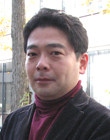
Tsuyoshi Mifune [profile]
Education Course
Growing distrust of politics
Tsuyoshi Mifune
Professor, Faculty of Economics, Chuo University
1. Introduction
During international comparative research for distrust of politics, it has been indicated that Japan has experienced prolonged distrust of politics at a relatively high level. Furthermore, this distrust of politics in Japan has increased rapidly since the late 1990s. There is little research focusing on the prolongation of distrust of politics in Japan. Moreover, many elements of the reason for this increasing trend in distrust of politics have yet to be clarified. In this article, I will use the perspective of cohorts (groups which share the same period of inception) to clarify a factor which shows a prolonged increasing trend in distrust of politics in Japan.
2. What is distrust of politics?
DDistrust of politics is a general name for the negative perception of politics held by citizens. A major theme of previous research has been to define the meaning of "politics" in the phrase distrust of politics. As the operating concept for distrust of politics, this research uses negative responses to the question "Can the nation's politics be trusted?" which is used in the majority of social surveys in Japan. The reason for this is quite passive: this question is the only data which enables assessment of long-term changes in distrust in politics. Still, when using data from this question, the target of distrust of politics is still unclear.
In America, the researchers Miller and Citrin have debated the target of distrust of politics. Their debate focused on whether the target of distrust is politicians or the political system itself. At that time, these two categories were not separated in surveys in America. This point of debate was replaced with the hypothesis that, if distrust of politics exists for a long period of time, citizens will begin to mistrust the entire political system even if the administration changes (Yamada, 1994, p. 138). This hypothesis was formed for an America in which there was prolonged distrust of politics. This debate in America gives an important hint for examining changes in distrust of politics in Japan, which has remained at a high level for a long period and even shows an increasing trend. When reviewing data from various surveys since 1976, distrust of politics increases when a political incident occurs or when there is a low support rate for the administration at that time. Conversely, distrust of politics decreases when there is a high support rate for the administration. When examined over the long-term, distrust of politics in Japan shows an increasing trend as in Figure 1.
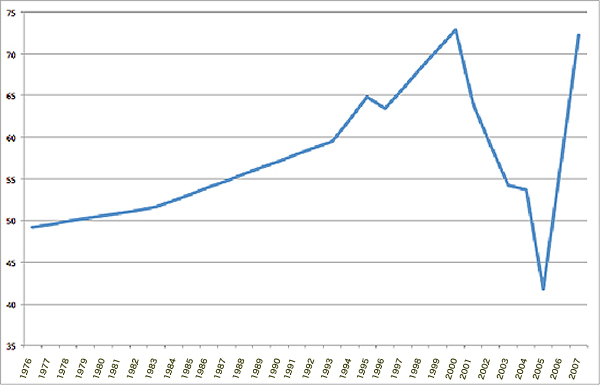
Figure 1: Changes in distrust of politics in Japan
"Can the nation's politics be trusted?"-Although this question asks about the nation's politics, the content is ambiguous. It is naturally to think that the question includes both politicians and the political system. However, by using appropriate methods to conduct causal analysis for this question's data, it is possible to identity the content of distrust of politics. Period factors such as scandals by politicians and public officers are associated with the beginning of formation for distrust of politics. If distrust of politics was an expression of transient dissatisfaction by citizens, distrust of politics would decrease once that dissatisfaction was eliminated. However, distrust of politics in Japan remains at a constant level and shows an increasing trend. Therefore, we can hypothesize that the background of long-term increases in distrust of politics even during administration changes can be attributed to a transformation of transient distrust of politics in relation to a political incident. This distrust is then accumulated as distrust of the entire political system.
3. Analysis themes
Analysis of the proceeding hypothesis includes clarification of two issues from data constraints. The first issue is the same as the point of debate in America: "Is increased distrust of politics in Japan caused by transient distrust towards political parties or politicians, or is it distrust of the political system?" The second issue focuses on the following question: "Does the background of long-term increase in distrust of politics include distrust towards politicians and political changing/intensifying into distrust of the political system, and the accumulation of this distrust in society?" By clarifying these two issues, it is possible to verify the cause of increased distrust of politics.
For these analysis themes, my research uses the Bayesian cohort model formulated by Nakamura (1982, 2005) in order to separate the effects of age factors, period factors and cohort factors associated with distrust of politics, to clarify the realities of distrust of politics, and to explain the long-term increasing trend in distrust of politics in Japan.
In cohort models, period effects are extracted as only a response to period factors at a single point of time for an individual, without regard to age or generation. Therefore, even if the individual has a vague image of the political party, politician or political system, only the period factor for that time is reflected. Therefore, it is criticism of the political party or politician at each period in time. Accordingly, the period effect can be interpreted as showing distrust of politics which is a manifestation of dissatisfaction towards political parties or politicians at that particular time.
The age effect can be considered as the extraction of mid-term distrust which originates in a particular life stage. However, such distrust should be resolved if the administration at that time implements policies to alleviate the distrust. Therefore, the life stage factor can also be classified as a type of distrust towards political parties or politicians. The age effect can be interpreted as showing the transformation of distrust of politics that originates in the policy compatibility for each age group, or originates in the distancing from social life caused by aging.
Conversely, the cohort effect is a common trend observed in individual born in a certain period. This trend differs from other generations. It is not influenced by conditions or age at the time of the survey. Rather, it is formed based on the individual's experience in the political socialization process. Therefore, it is not distrust of politics towards a political party or politician at a certain point in time. Accordingly, the residual distrust of politics is not a specific target; instead, it is deepened distrust of the political system. This is expressed as the cohort effect.
4. Data and Bayesian cohort model
The data used in the analysis is from 11 points in time from 1976 to 2007. The data uses a response ratio which is the total of negative responses "can sometimes be trusted" and "cannot be trusted at all" in a 4-stage scale.
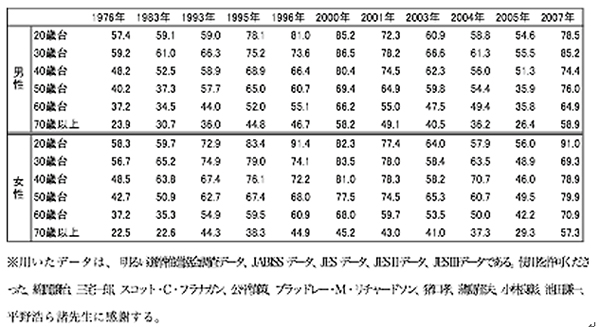
Table 1: General cohort table formulated from data
The classical method for cohort analysis is to interpret the movement of numbers from a standard cohort table or a general cohort table. Table 1 is a general cohort table formulated from data.
Generally speaking, it is difficult to interpret each effect from numbers in the cohort table. This is regarded as an awareness problem. A method for overcoming this problem was the theme of methodological research.
The research published by Nakamura (1982) overcome this awareness problem and is known as the Bayesian cohort model. Fundamentally, analysis using the Bayesian cohort model divides dependent variables into the three factors of age, period and cohort.
5. Analysis results
The top half of Figure 2 shows analysis results for men and the bottom half shows results for women. Although detailed results are omitted, 3 effects exist because the APC model's ABIC is the smallest. From the left, Figure 2 shows the estimated values for the period effect, age effect and cohort effect. The estimated values are relative values using a zero-sum constraint of parameters within each effect. Increase in distrust of politics (higher ratio of distrust of politics) is shown by positive numbers. Larger numbers show greater increases. In the following section, I will discuss the characteristics of each effect for both men and women.
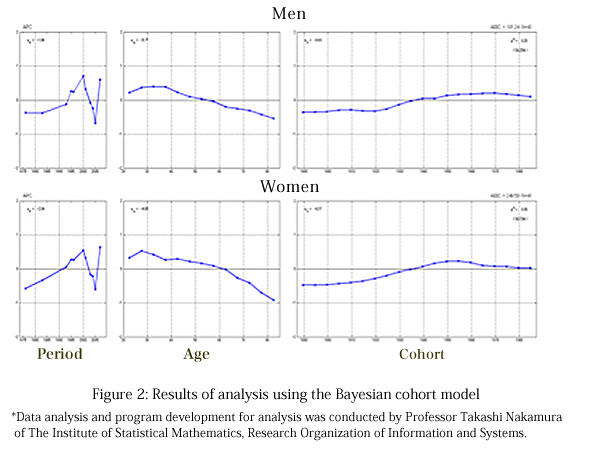
(Period Effect)
The effect is high for both men and women in 1976, 1996, 2000 and 2007. This shows relatively high levels of distrust of politics. The Lockheed scandal occurred in 1976. 1996 was the period of party realignment which had continued to ignore voters since 1993. In 2000, Prime Minister Mori's incriminating remarks and lack of crisis management skills were exposed. Therefore, it can be interpreted that the political scandals of these politicians and other factors increased distrust regardless of age and generation. Afterwards, during Koizumi's administration from 2001, distrust decreased among a background of a high support rate. However, during Abe's administration from autumn 2006, there was a series of incidents such as the suicide of Agriculture Minister Matsuoka. The media ridiculed the collapse of the cabinet and distrust increased.
(Age Effect)
For both men and women, the effect increases until the 20s and 30s. The effect then remains at a high level until the 50s and decreases from the 60s. This is because both men and women get married and form a family in their 20s and 30s. It is also the period where they assume important social responsibility at their workplace. The reason for the decreasing effect from the 60s is because men and women retire from their workplace and have lessening responsibility in the household, thus becoming more conservative.
(Cohort Effect)
Trends are almost the same for both men and women. Characteristics show major changes beginning from the birth cohorts from 1940 and later. Individuals born before the 1940s show a relatively low effect. However, individuals born after 1940 show an effect of heightening distrust. This difference arises due to whether or not the individual has experienced the political socialization in the system prior to WWII. Before WWII, the absolute Emperor system and militarism did not allow citizens to criticize politics. Furthermore, criticism of politics by the mass media is significantly different before and after WWII. Birth cohorts from 1940 to 1975 have experienced political socialization within the democratic system following WWII. In that process, major political incidents were extensively covered in newspapers and on television. If an individual experiences several such incidents within the political socialization process, it is sufficient to form distrust of politics. This is expressed as generational differences in the cohort effect. Of course, there were numerous political incidents prior to WWII. However the cohort effect shows that, for before and after WWII, there were major differences in social conditions attached to individuals from different generations.
The cohort effect is the process of latent distrust of politics possessed by each birth cohort. Based on a particular phenomenon which is a shared experience of each birth cohort within the political socialization process, the cohort effect shows the effect established by that phenomenon increased or decreased political distrust. Therefore, the effect is regarded as constant after the phenomenon. However, the meaning of the cohort effect differs from the period effect. If the cohort effect is large, the associated birth cohort possesses distrust of politics even if the period factor from a certain point in time decreases the distrust of politics. This clearly indicates that transient distrust of politics deepens into distrust of the political system. As shown in Figure 2, birth cohorts after 1940 possess a high effect for distrust of politics. If we conduct a more detailed analysis (Figure 3-1, 3-2) for the extent that the 3 effects contribute to distrust of politics, the contribution of the cohort effect increases for both men and women from 2000.
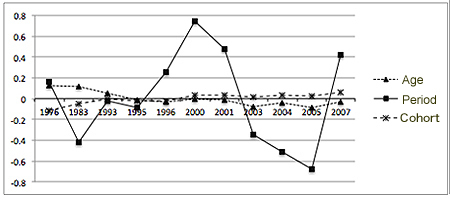
Figure 3-1: Change in 3 effects (men)
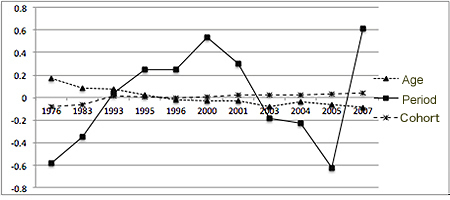
Figure 3-2: Change in 3 effects (women)
The reason that birth cohorts with a high cohort effect exist after 1940 is that birth cohorts with a high cohort value assumed a central economic position in society and were accumulated in society, thus causing an increase in the ratio of distrust of politics in overall society. Moreover, the properties of the cohort effect express distrust of the political system, not distrust towards individual administrations. Therefore, the gradually increase in the cohort effect since 2000 shows there is continued deepening distrust of political systems at a constant level, despite fluctuations in the period effect.
These effects all imply that a significant level of distrust of politics will continue to exist at the core of Japanese society in the foreseeable future, even if an administration with a high support rate appears.
Nakamura, Takashi. 1982. "Bayesian Cohort Model-Application to Standard Cohort Tables," Ann. Inst. Statist. Math., Vol. 29, p. 77-97.
Yamada, Kazunari.1994. "Political Alienation and Political Behavior," Social Psychology of Political Behavior, edited by Hiroshi Akuto, Fukumura Publishing.
Nakamura, Takashi. 1986. "Bayesian Cohort Models for General Cohort Table Analysis," Ann. Inst. Statist. Math., Vol.32, pp.353-370.
- Tsuyoshi Mifune
Professor, Faculty of Economics, Chuo University - Born in Tokyo in 1966. In 1998, completed the Doctoral Program at the Graduate School of Law and Politics, Keio University. Holds a PhD in law from Keio University.
Has served as a Fellow (DC2) at the Japan Society for the Promotion of Science, as well as an Instructor and then Associate Professor at Aichi Gakusen University. Assumed his current position in April 2012. Became a Director at the Japan Political Science Association in October 2012. - His current research focuses mainly on changes in the political participation behavior of Japanese people. His research also focuses on analysis through game theory which uses a framework for spatial theory in political science in order to compare the preferred policy of voters and the preferred policy of political parties.
- Major written works:
His major written works include Structure and Changes of Political Participation and Awareness in Modern Japan-Construction of a civic society through participation and vulnerability of that society (Keio University Publishing, 2008) and Decreased Voter Turnout-Analysis of decreased voter turnout for Lower House elections in the 1990s (Annual Report: Political Science 2005-I, Vol. 1, p. 135-160, 2005)
- Research Activities as a Member of Research Fellowship for Young Scientists (DC1), Japan Society for the Promotion of Science (JSPS) Shuma Tsurumi
- Important Factors for Innovation in Payment Services Nobuhiko Sugiura
- Beyond the Concepts of Fellow Citizens and Foreigners— To Achieve SDGs Goal 10 “Reduce Inequality Within and Among Countries” Rika Lee
- Diary of Struggles in Cambodia Fumie Fukuoka
- How Can We Measure Learning Ability?
—Analysis of a Competency Self-Assessment Questionnaire— Yu Saito / Yoko Neha - The Making of the Movie Kirakira Megane








